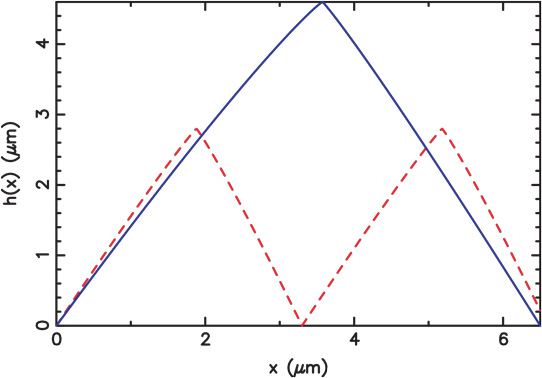A Mayer and A Bay of University of Namur in Belgium have applied a 'genetic algorithm' to the problem of finding optimal surface textures for light extraction from gallium nitride (GaN) light-emitting diodes (LEDs) [Journal of Optics, vol17, p025002, 2015].

Figure 1: Optimal shapes for surface texturing of GaN LED when optimizing on (i) P, H, c, αleft and αright with ε = 2.763 (solid), and (ii) P, H, c, αleft and αright and ε (dashed). Parameters associated with these structures are given respectively in the third and sixth line of Table 1.
GaN LEDs suffer from low light extraction due to the large contrast in refractive index with air, leading to reflection back into the device (killing efficiency). Compared with an extraction efficiency (η) of 3.7% for a flat GaN surface, Mayer and Bay found an optimal texturing (Figure 1, Table 1) giving 11.1% - a factor of three improvement.
Table 1: Optimal parameters for surface texturing of GaN LED with corresponding values for light-extraction efficiency. Six lines correspond to different optimizations by the GA with included parameters underlined.

The researchers also applied the genetic algorithm to samples with restricted parameters such as fixing the dielectric constant to that of a popular photoresist (2.763). It was found that a textured layer with the same dielectric constant as GaN (6.34) gave better performance.
Genetic algorithms are search techniques inspired by the process of natural selection: the parameters to be optimized are encoded as 'DNA' and a sample population with various DNA profiles is subjected to mutation and cross-over processes. The rates of mutation and cross-over have to be chosen so that the parameter space is adequately explored while at the same time the process should converge on an optimal output.
One of the researchers, Annick Bay, previously worked on light extraction from the bioluminescent organs of fireflies. Mayer and Bay comment: "This study showed that the surface of the cuticle of fireflies presents jagged scales, which turn out to increase light extraction significantly in comparison to a planar surface."
Inspired by this work, Mayer and Bay have been working on getting similar results for GaN LEDs. The researchers used a two-dimensional rigorous coupled-waves analysis to calculate the extraction efficiency of textured layers with triangular texturing. The target wavelength was 425nm. The period (P) and height (H) of the triangles were varied, along with the position of the center (c). The left and right sides of the triangles were also allowed to bend in a concave or convex sense using a power-law exponent (α). The dielectric constant (ε) that controls the refractive index of the textured layer was also potentially variable.
Full variation of the six parameters with suitable steps would have needed to test some 50 trillion instances. The genetic algorithm required 2235 20-hour fitness evaluations over 60 generations. The researchers used a 'tier 1' supercomputer that allowed fitness evaluations to be carried out in parallel. The whole process took 2100 hours (3 months, 45,000 cpu hours).





